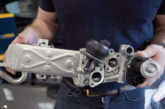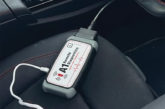For the aftermarket, ‘fake news’ is an increasingly serious problem, but more in the shape of ‘fake parts’. With this worrying trend showing no signs of slowing down, Neil Pattemore details the risks of installing these parts, and examines how you can detect a fake in the first place.
Counterfeit parts are a significant problem and are often difficult to tell apart from the genuine article. New figures released by the European Commission at the end of 2018 showed that customs authorities detained over 31 million fake and counterfeit products at the EU’s external border, with a street value of over €580 million.
IPR infringing goods shipped to the EU were mainly sourced from China, accounting for over 85% of all counterfeit goods, but they also came from Turkey, India and Egypt.
Pierre Moscovici, Commissioner for Economic and Financial Affairs, Taxation and Customs, said, “The EU’s Customs Union is on the front line when it comes to protecting citizens from fake, counterfeit and sometimes highly dangerous goods. Stopping imports of counterfeits into the EU also supports jobs and the wider economy as a whole.”
So, for the vehicle repair workshop, how do you know if the parts you are buying and fitting to your customers’ cars are the genuine article? Equally, if they are counterfeit, what is the problem?
Increasingly, this is about being suspicious, vigilant and simply just using your common sense to look for the signs that help to detect counterfeit goods:
■ Inspect the packaging carefully. The packaging of infringing goods is often a giveaway and doesn’t indicate the address of the manufacturer and the importer. Furthermore, many genuine parts manufacturers mark their products with holograms, control numbers and/or other security measures.
■ Check if logos and trademarks are displayed correctly. At first glance, an infringing product may appear identical to the genuine one. However, on a closer inspection, you may be able to identify some differences. For example, logos may be badly reproduced and trademarks deliberately or accidentally misspelled.
■ Examine the quality of the product. The ‘look and feel’ of the product is an indication that the quality of the product is lower than that of the original.
■ Be wary of unusually low prices. Although not all fakes are sold at a lower price than the genuine article, a suspiciously low price is still a good indicator. If it looks too good to be true, then it probably is.
“Although not all fakes are sold at a lower price than the genuine article, a suspiciously low price is still a good indicator. If it looks too good to be true, then it probably is.”
- When buying goods over the internet, do not hesitate to ask precise questions to the sellers or auctioneers in order to get more information about the supply chain and to make sure that the goods are coming from a legal source.
- Check the instructions manual. Normally it should be in your language and should not contain grammar or spelling mistakes.
- When in doubt, contact or check out the website of the manufacturer of the genuine product. Many genuine parts manufacturers have information on their websites to help customers detect fakes, including pictures and descriptions of the originals.
If a counterfeit part is identified, there are a number of increasingly serious issues for the workshop, ranging from parts not fitting or working correctly and you having to take the time and trouble to source the genuine part, through to creating a repair on your customer’s vehicle which may not provide the function or duration that it should, to a direct legal liability, especially if the vehicle is involved in an accident through a failure of the counterfeit part.
So, how best to avoid these risks? Your protection comes from following the process for claiming guarantee or warranty support for ‘faulty’ legitimate parts, which would be for the workshop to follow the ‘audit trail’ back to the parts supplier and ultimately back to the ‘genuine’ part’s manufacturer.
You could alleviate this risk by buying OE parts from the vehicle manufacturer, although this may restrict your repair offer or competitive pricing offer. If you buy an aftermarket branded part, it becomes more about the reputation of the brand, but the best way to protect yourself is to buy from an established and reputable parts supplier, and retain the invoice for the part to establish the audit trail should a problem occur.
For the workshop, the best advice is to be increasingly suspicious, follow the checklist of how to assess if a part may be counterfeit, and use your common sense. Work on the principle of ‘buyer beware’; choose your suppliers carefully, keep accurate records for the parts that you buy, in case you need to prove from whom you bought them, and don’t be tempted by just the lowest price. Remember, fake parts are designed to deceive.











